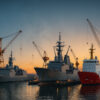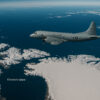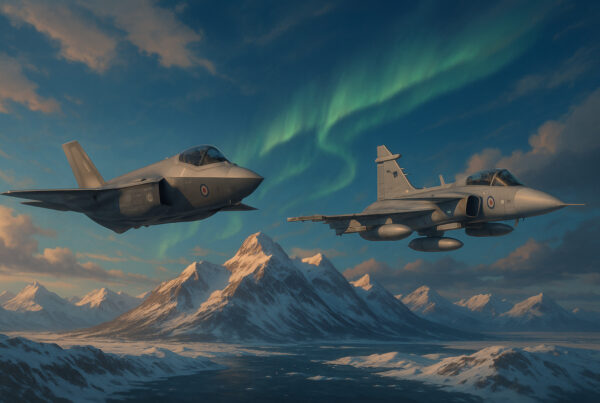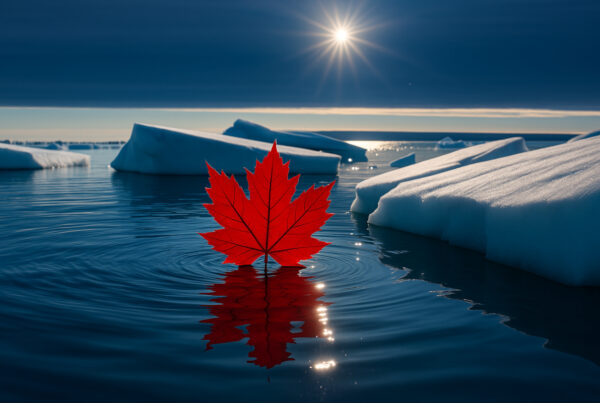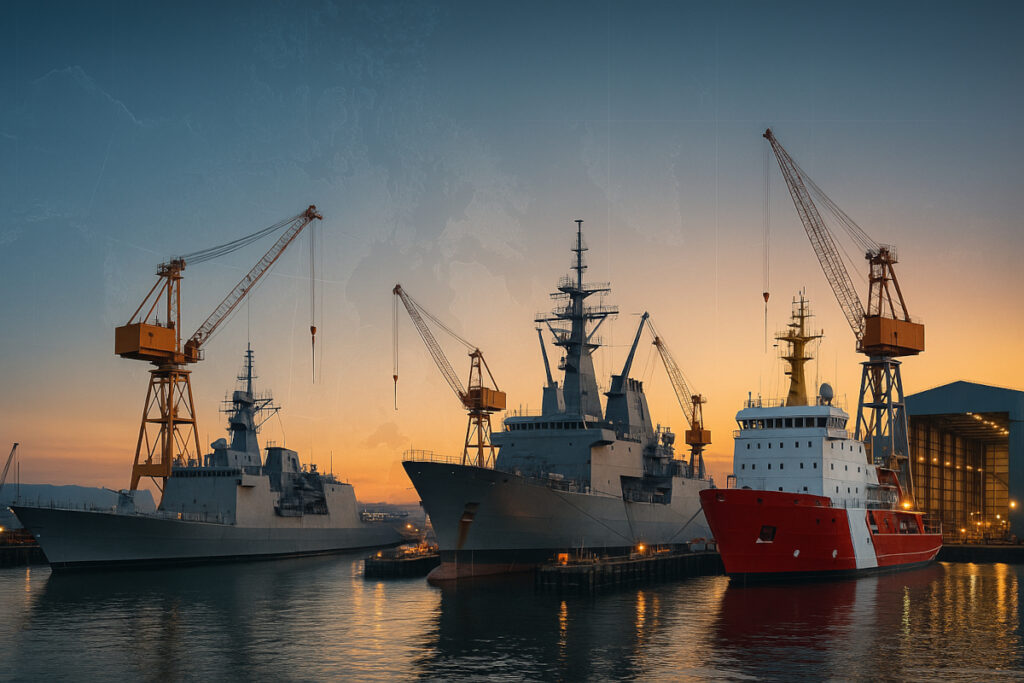 Written by Carter J. Lewis
Written by Carter J. Lewis
Canada’s National Shipbuilding Strategy (NSS) is a crucial element of our national security. The NSS is a long-term initiative with the aim of rejuvenating Canada’s maritime capabilities through the construction of new vessels. This is key to ensuring the Royal Canadian Navy (RCN) has the ships it needs to defend Canadian waters and participate in international missions. Our National Shipbuilding Strategy has 3 main elements. The construction of large vessels, the construction of small vessels as well as a repair, refit and maintenance elements. For this task the government selected Seaspan Vancouver Shipyards co. for the construction of non-combat vessels and Irving Shipbuilding Inc. in Halifax. Procurement Canada then selected Chantier Davie Canada as its third NSS shipyard.
Seaspan’s Vancouver Shipyards Co. Ltd.
- 2 Joint Support Ships
- 16 Multi-Purpose Vessels (MPV)
- 3 offshore fisheries science vehicles
- 1 Offshore oceanographic science vessel (OOSV)
- 2 Polar Ice breakers
Irving Shipbuilding Inc.
- 15 River-class destroyers
- 6 Arctic and offshore patrol AOPS ships RCN
- 2 AOPS Canadian Coast Guard
Chantier Davie Canada
- 2 Polar Icebreakers
- 6 Program Icebreakers
-
Seaspan Vancouver
Seaspan operates three separate shipyards on the Pacific Northwest Coast. Vancouver Shipyards, Vancouver Drydock and Victoria Shipyards are all notable due to their ability to provide a complete range of shipyard services including new construction, conversion, refit and repairs. Seaspan’s role in constructing surface vessels for the RCN and Canadian Coast Guard (CCG) must be maintained. This construction as well as maintenance and refurbishing capabilities for all vessels in the RCN and CCG are an integral part of our national security and must be treated as such.
Seaspan is currently building two RCN Joint Support ships, also known as Auxiliary Oiler Replenishment vessels (AORs). These will be purpose built multi-role vessels crucial to refuelling and replenishing RCN combat vessels operating far from port. Ever since our previous two AORs were taken out of service in 2015 and 2016 along with two Iroquois class destroyers, the RCN has lacked the capacity to refuel and resupply our ships at sea. Previously, NATO and other coalition task forces could rely on Canada to be able to resupply their ships at sea. Currently, we do not have the ability to provide underway support to our own ships at sea. Underway support and replenishment include the re-supply of food, fuel, ammunition, spare parts, and other supplies. In 2018, Seaspan started to build HMCS Protecteur. Delivery is expected in 2026. In 2022 Seaspan started to build HMCS Preserver. Delivery is expected in 2027. These new AORs will provide the RCN and our allies with much needed support at sea. Not having enough of these vessels at sea is detrimental to any RCN operation. While the arrival of these ships will be a much-welcomed addition to our Navy, we must assure that our fleet never goes with AORs again. The OOSV that Seaspan is building for the CCG will serve as its primary oceanic science vehicle to support Fisheries and Oceans Canada. With its extensive sonar suite and portable labs, the OOSV will meet its mission to increase our overall understanding of our oceans, currents and the seabed. The OOSV along with the 3 Offshore Fisheries Science Vessels that Seaspan has built for the CCG will be a formidable addition to Canada’s fleet. The 16 MPVs that Seaspan is building for the CCG will provide the fleet with the versatility necessary to carry out a variety of mission types across the country. These missions could include icebreaking in moderate conditions, maritime search and rescue, scientific research and environmental response. These vessels will operate year-round, within Canada’s Economic Exclusion Zone (EEZ) as well as in the St. Lawrence River and the Great Lakes. Canada’s Polar Icebreakers will be capable of year-round operations in our northern EEZ. These vessels will bring crucial search and rescue, marine navigation and icebreaking capabilities to the CCG while enhancing its logistical abilities. By supporting Canada’s Arctic missions, sovereignty and presence, this is a vessel that is essential for Canadian power projection.
-
Irving Shipbuilding
Irving operates four separate production facilities on the east coast. Their facilities at Halifax Harbour are designed to build ships for Canada’s Navy. The harbours Assembly and Module Hall support large and modern under-cover shipbuilding operations. This will be the location where River-class destroyers are built and maintained. The facility’s Omnilift Shiplift will be the largest shiplift in the Americas. Marine Fabricators located in Dartmouth, NS provides steel burning, cutting, forming and fabrication for Irving. This facility is responsible for carrying out initial work preparing steel for shipbuilding. Raw steel is delivered to this facility to be cut, molded and kitted. The kitted steel is then delivered to Halifax Harbour. Woodside Industries, close to Halifax Harbour, supplements build capacity at the harbour. Sections of ships being constructed at harbour are fabricated at Woodside and transported to the shipyard for further assembly. Irving’s new Bluenose Building is their state-of-the-art office building that is home to one of the largest engineering work forces in Canada.
The River-class destroyer will ensure the RCN continues to patrol our waters and contribute to coalition naval missions with significant warships. These will be the RCNs primary surface component. With a top speed of 27 knots and a range of 7,000 nautical miles, these are long endurance, fast and highly maneuverable warships. These guided missile destroyers significantly improve the lethality of the RCN. Equipped with a vertically launched missile system and torpedoes these warships offer anti-air and ship capabilities; essential to power projection and international operations. Their 127mm main gun and 30mm gun systems offer increased short range firepower flexibility.
The Arctic Offshore Patrol Ship (AOPS) was designed and built to provide increased presence and conduct surveillance operations through Canadian waters. These Harry DeWolfe-class vessels provide the RCN and CCG with a larger fleet with enhanced capabilities. The AOPS will take over the patrol of Canadian waters while giving our frigates and destroyers the ability to participate in International Maritime Organization (IMO) tasks. The IMO is an agency of the United Nations responsible for the safety and security of international shipping and the prevention of maritime pollution by ships. Canada has always been a strong contributor to the IMO. Our frigates continue to partake in operations such as Horizon and Neon where multinational exercises and maneuvers took place. Building AOPS frees up our frigates to spend more time abroad contributing to IMO and NATO missions. The value of being able to shift all frigates to international waters while having full coverage of Canadian waters with AOPS vessels should not be underestimated. This is an integral part of the Canadian Government’s National Shipbuilding Strategy. In 2014 the AOPS project commenced and since then 5 out of the promised 6 ships have been delivered. AOPS is key to our power projection into the arctic.
-
Chantier David Canada
To increase our shipbuilding capabilities and expand the footprint of our navy, Canada should commit to building more. We must fulfill our commitments to the NSS. Continue to issue more contracts to Canadian shipbuilders and support them. Doing this has a significantly positive benefit to the Canadian people and our national defence. The bungled ferry contract being awarded to Chinese shipbuilders confirms the double standard and lip service being trotted out by Canadian leadership, they must do more to support Canadian industries. Outsourcing key sources of revenue is not tactically prudent. However, there seems to be something larger at play as reports indicate that Canadian firms felt hard done by the governments bidding and procurement process. As British Columbia’s biggest shipyard Seaspan says “building the next wave of ferries in the province is absolutely a priority, but will require political will on the part of decision makers.” Invest in Canadian workers and industries, full stop and if it can’t be a solely Canadian project then partner with American firms. The motto of the Royal Canadian Navy, Ready, Aye, Ready takes pride in our sailor’s commitment to stand ready to defend Canada. Our ability to defend Canadian waters by projecting power into our Economic Exclusion Zone and to participate in IMO missions is significantly reduced by not operating the vessels such as AORs and Icebreakers that are crucial to RCN and CCG operations. The RCN must never be without mission critical ships again. Due to these companies’ commitments to local communities, conservation and security this is an important opportunity for the Canadian people.
Sources:
“Shipbuilding.” Seaspan, 10 Dec. 2024, www.seaspan.com/seaspan-shipyards/shipbuilding/.
“Multi-Purpose Vessels.” Seaspan, 29 Oct. 2024, www.seaspan.com/seaspan-shipyards/shipbuilding/multi-purpose-vessels/.
“Facilities.” Irving Shipbuilding, shipsforcanada.ca/about/facilities. Accessed 10 Apr.2025.
Canada, Public Services and Procurement. “Government of Canada.” Canada.Ca, /Gouvernement du Canada, 5 Feb. 2025, www.canada.ca/en/public-services-procurement/services/acquisitions/defence-marine/national-shipbuilding-strategy/projects/large-vessels.html.
Canada, Public Services and Procurement. “Government of Canada.” Canada.Ca, /Gouvernement du Canada, 2 Jan. 2025, www.canada.ca/en/public-services-procurement/services/acquisitions/defence-marine/national-shipbuilding-strategy/projects/large-vessels/arctic-patrol-navy.html
“Canada’s Davie Sees US Shipyards Key to Winning Icebreaker Contract.” Reuters, 20 Aug. 2025, Canada’s Davie sees US shipyards as key to winning icebreaker contract
“‘It Can’t Just Be a Competition on Price’: Why Seaspan Didn’t Bid on BC Ferries Contract.” Global News, 20 Aug. 2025, https://globalnews.ca/news/11272269/bc-ferries-seaspan/.

